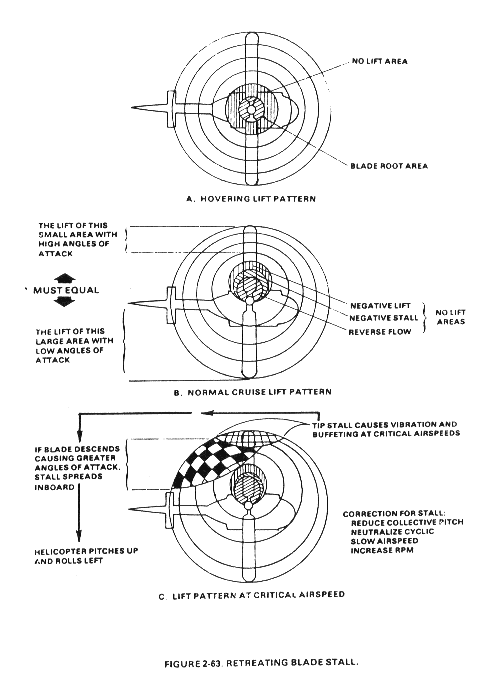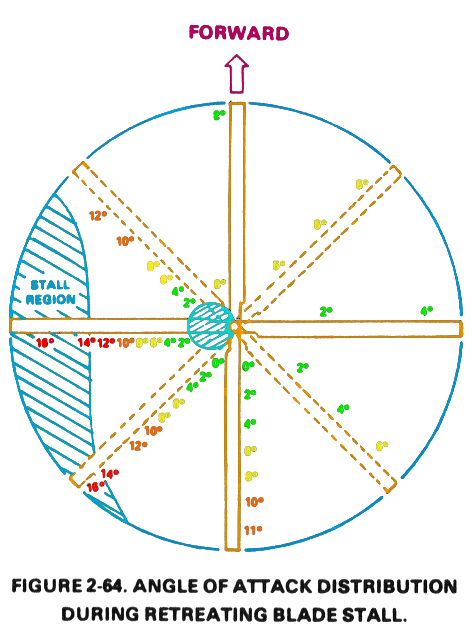[Top]
[Up]
[Prev]
[Next]
Retreating Blade Stall
A tendency for the retreating blade to stall in forward flight is inherent
in all present day helicopters and is a major factor in limiting their
forward speed. Just as the stall of an airplane wing limits the low speed
possibilities of the airplane, the stall of a rotor blade limits the high
speed potential of a helicopter. The airspeed of the retreating blade (the
blade moving away from the direction of flight) slows down as forward
speed increases. The retreating blade must, however, produce an amount of
lift equal to that of the advancing blade. Therefore, as the airspeed of
the retreating blade decreases with forward aircraft speed, the blade
angle of attack must be increased to equalize lift throughout the rotor
disk area. As this angle increase is continued, the blade will stall at
some high forward speed.
As forward airspeed increases, the "no lift" areas move left of center,
covering more of the retreating blade sectors:

This requires more lift at the outer retreating blade portions to
compensate for the loss of lift of the inboard retreating sections. In the
area of reversed flow, the rotational velocity of this blade section is
slower than the aircraft airspeed; therefore, the air flows from the
trailing to leading edge of the airfoil. In the negative stall area, the
rotational velocity of the airfoil is faster than the aircraft airspeed,
therefore air flows from leading to trailing edge of the blade. However
due to the relative arm and induced flow, blade flapping is not sufficient
to produce a positive angle of attack. Blade flapping and rotational
velocity in the negative lift area are sufficient to produce a positive
angle of attack, but not to a degree that produces appreciable lift.
This figure shows a rotor disk that has reached a stall condition on the
retreating side:

It is assumed that the stall angle of attack for this rotor system is 14
degrees. Distribution of angle of attack along the blade is shown at eight
positions in the rotor disk. Although the blades are twisted and have less
pitch at the tip than at the root, angle of attack is higher at the tip
because of induced airflow.
Upon entry into blade stall, the first effect is generally a noticeable
vibration of the helicopter. This is followed by a rolling tendency and a
tendency for the nose to pitch up. The tendency to pitch up may be
relatively insignificant for helicopters with semirigid rotor systems due
to pendular action. If the cyclic stick is held forward and collective
pitch is not reduced or is increased, this condition becomes aggravated;
the vibration greatly increases, and control may be lost. By being
familiar with the conditions which lead to blade stall, the pilot should
realize when his is flying under such circumstances and should take
corrective action.
The major warnings of approaching retreating blade stall conditions are:
- Abnormal vibration
- Pitchup of the nose
- Tendency for the helicopter to roll in the direction of the
stalled side.
When operating at high forward airspeeds, the following conditions are
most likely to produce blade stall:
- High blade loading (high gross weight)
- Low rotor RPM
- High density altitude
- Steep or abrupt turns
- Turbulent air
When flight conditions are such that blade stall is likely, extreme
caution should be exercised when maneuvering. An abrupt maneuver such as a
steep turn or pullup may result in dangerously severe blade stall.
Aircraft control and structural limitations of the helicopter would be
threatened.
Blade stall normally occurs when airspeed is high. To prevent blade stall,
the pilot must fly slower than normal when:
- The density altitude is much higher than standard
- Carrying maximum weight loads
- Flying high drag configurations such as floats, external
stores, weapons, speakers, floodlights, sling loads, etc.
- The air is turbulent
When the pilot suspects blade stall, he can possibly prevent it from occurring by sequentially:
- Reducing power (collective pitch)
- Reducing airspeed
- Reducing "G" loads during manuevering
- Increasing RPM to upper allowable limit
- Checking pedal trim
In severe blade stall, the pilot loses control. The helicopter will pitch
up violently and roll to the left. The only corrective action then is to
accomplish procedures as indicated previously to shorten the duration of
the stall and regain control.
Paul Cantrell
paul at copters.com
(replace " at " with "@" to email me - this avoids SPAMMERS I hope)
[Top]
[Up]
[Prev]
[Next]


